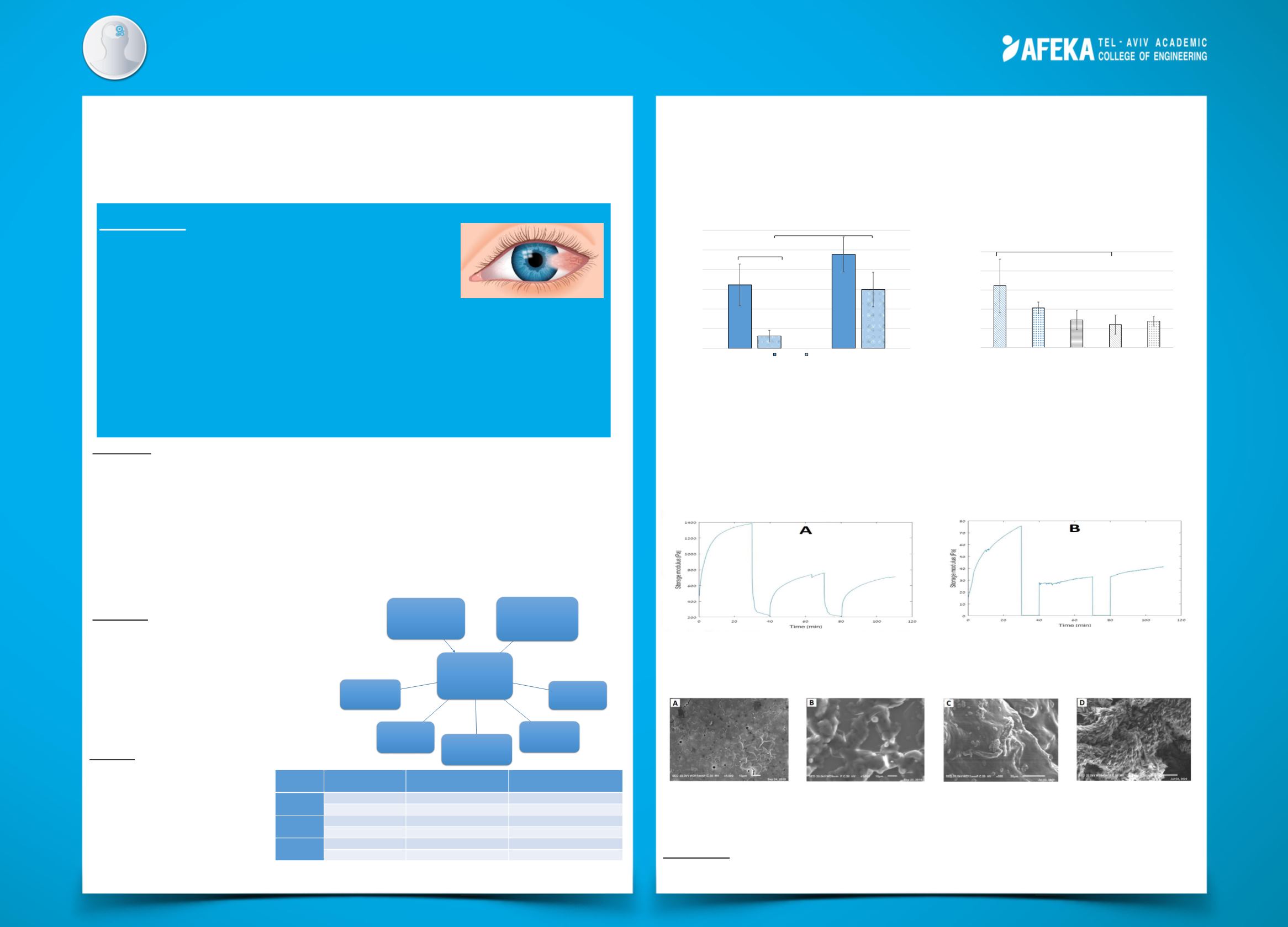

Commercial
vs
semi- autologous
fibrin glue
Objective:
•
To examine the
potential
of semi-autologous fibrin glue, in which the thrombin component
is commercial, and the fibrinogen component is produced from blood donation (patient's
blood), as a cheaper, safer and biocompatible alternative to commercially available fibrin
glue.
•
Fibrinogen concentration
quantification
of both commercial and semi-autologous samples.
•
Characterization
the
adhesive
properties, as well as the
rheological
and
microstructure
features of semi-autologous fibrin glue compared to the commercial fibrin glue.
•
Understanding the effect of fibrinogen concentration on the properties of the fibrin glue.
Methods:
1:1 volumetric ratio between
fibrinogen and thrombin was mixed in
both commercial and semi-autologous
fibrin glues and the data was
analyzed and compared.
Shavit Tabo, Shani Yeshayahu, Reut Kesner
Advisor: Dr. Moran Aviv
Medical Engineering
Abstract:
In this study, we compared semi-autologous
and commercial fibrin glue that is being
used in Pterygium surgeries [Figure 1].
We examined their bonding strength, rheological properties, and
microstructure.
Preliminary results show the great potential of the
semi-autologous glue as an alternative to the commercial glue.
►
Rheological Properties:
Significant differences are observed in the rheological properties between the commercial
and the semi-autologous glue. The rheological results of the commercial glue shows
supremacy over the semi-autologous sample. The
gelation time
could not be determined
because the adhesives did not reach a stable storage modulus state. In addition, the
stiffness
of the commercial glue is higher than the semi-autologous glue, as represented by
the storage modulus. Moreover, both adhesives are not
thixotropic
as they exhibit the
same behavior and reach about 50% of its initial state after destruction (Figure 4).
Figure 4. Thixotropic test. (A) Commercial glue; (B) Semi-autologous fibrin glue
.
►
Microstructure:
The semi-autologous glue seems promising, as in both glues similar dense bundles of fibers
were observed, as shown in Figure 5.
Conclusion:
Semi-autologous fibrin glue might be suitable, and function as well as commercial fibrin glue in
pterygium surgeries, but further and deeper study is required .
Figure 1. Pterygium Illustration
Table 1. Fibrinogen origin and concentration used in each
experiment ( * Average of Commercial 2 & Commercial 3).
Fibrin Glue
Characterization
Semi-autologous
Fibrin Glue
Commercial
Fibrin Glue
Rheology
(Rheometer)
Adhesion
Strength
(Instron)
XRD
Microstructure
SEM
Fibrinogen
quantification
Results:
►
Fibrinogen Quantification:
The fibrin glues were evaluated
in their original concentrations,
and also at various fibrinogen
concentrations
(1, 5, 10, 25 and 50 [mg/mL]).
Experiment
number
Fibrinogen Origin Fibrinogen Concentration
[mg/mL]
Fibrinogen concentration
compared to commercial [%]
1
Commercial 1
44.7
100
Semi-autologous 1
6.47
14.4
2
Commercial 2
11.0 (*9.7)
100
Semi-autologous 2
8.39
86.5
3
Commercial 3
8.4 (*9.7)
100
Semi-autologous 1
6.47
66.7
Figure 5. SEM images of the 10% fibrin glues, X1000 (A) Semi-autologous fibrin glue,
(B) Commercial fibrin glue.
SEM images of the 5% commercial glue, X500 (C) Before rheological measurements,
(D) After rheological measurements.
Figure 2. Bonding strength for the original concentrations
►
Bonding Strength:
The two types of adhesives in their original concentration present the same scenario. As time
goes on, their adhesion strength increases. Significant differences in the adhesive strength are
shown between the two fibrin glues after 30 minutes. However, after 4 hours,
no significant
differences in adhesive strength are observed
(Figure 2).
There are no differences in the adhesion strength between the two fibrin glues, although the
fibrinogen concentration is different (Figure 3).
0
50
100
150
200
250
A_10
A_5
C_25
C_10
C_5
Bonding Strength [KPa]
*
Figure 3. Concentration effect on Bonding strength
0
50
100
150
200
250
300
t1
t2
Bonding Strength [KPa]
Commercial
Semi-Autologous
*
*
















